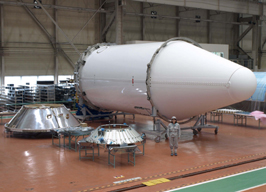H-IIA Launch Vehicle Fairing Delivered
Jun. 01, 2010

|
Tokyo, June 1, 2010 — Kawasaki Heavy Industries, Ltd. announced today that it has shipped a payload fairing (PLF*1) for the H-IIA Launch Vehicle No.18 to Japan's Tanegashima Space Center. Design and manufacturing of the PLF was performed at Kawasaki's Gifu Works before the fairing was assembled and shipped from its Harima Works. Upon arrival at the Tanegashima Space Center, the PLF will be delivered to Mitsubishi Heavy Industries, Ltd. who will be executing the launch. Mitsubishi will incorporate the PLF into the H-IIA Launch Vehicle No. 18 in preparation for the upcoming launch scheduled for this summer. The four-meter diameter PLF has a single launch configuration (4S) and can accommodate a large satellite. The H-IIA Launch Vehicle No. 18 will carry the Quasi-Zenith Satellite-1*2 (Michibiki) developed by the Japan Aerospace Exploration Agency (JAXA) in cooperation with related research organizations. Since delivering the first PLF for the H-II launch vehicle in 1993, Kawasaki has supplied payload fairings for a total of seven H-II launch vehicles. Kawasaki has a proven track record of designing and building a variety of PLFs for H-IIA launch vehicles, including four-meter single (4S), four-meter dual (4/4D), and five-meter single fairings (5S). These PLFs have been a key component in 17 H-IIA launch vehicles to date. Kawasaki has developed and manufactured a wide spectrum of H-IIA launch vehicle PLFs designed to meet a broad range of payload specifications, including the launch of large satellites as well as the simultaneous launch of two satellites. Kawasaki is playing a vital role in today's satellite launch industry via the development and production of cutting-edge PLFs.
*1. A payload fairing is an enclosure installed at the tip of a launch vehicle that protects the satellite from aerodynamic heating, acoustic noise and vibration during liftoff. After the launch vehicle leaves the earth's atmosphere, the fairing splits in two and is jettisoned, allowing the satellite to separate from the launch vehicle. *2. The Quasi-Zenith Satellite System (QZSS) makes it possible to provide high accuracy satellite positioning services covering nearly all of Japan, including urban canyons and mountainous terrain. Phase one of the QZSS project will demonstrate and validate the feasibility of the technology at work in the Michibiki, the first Quasi-Zenith Satellite. |
|||||||||||





